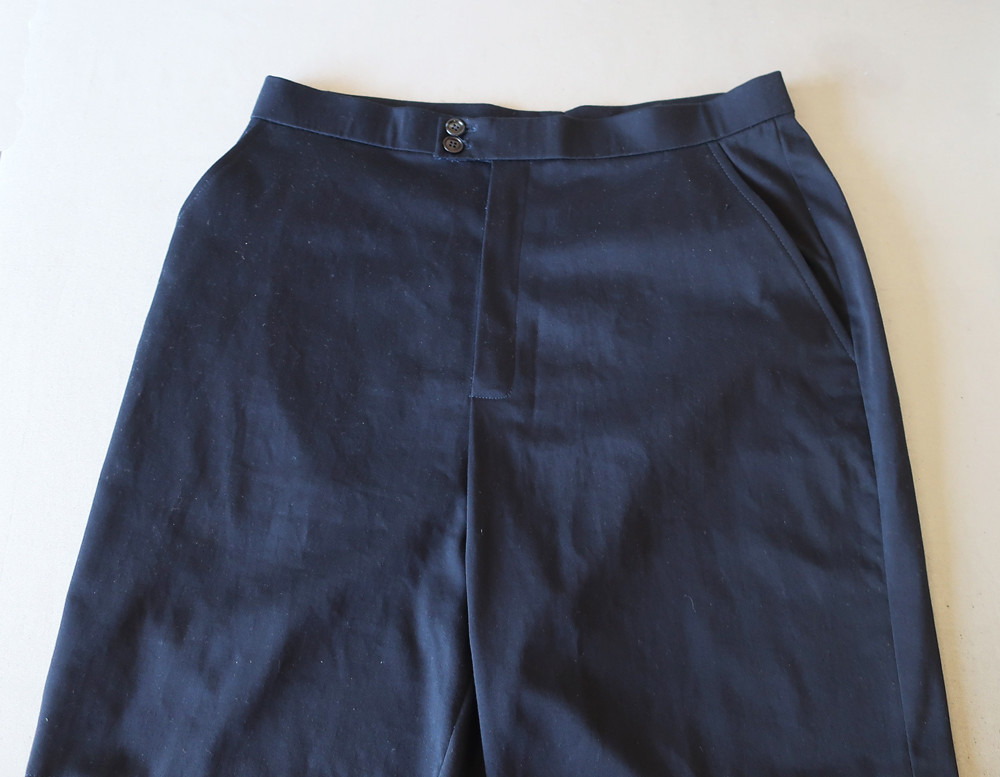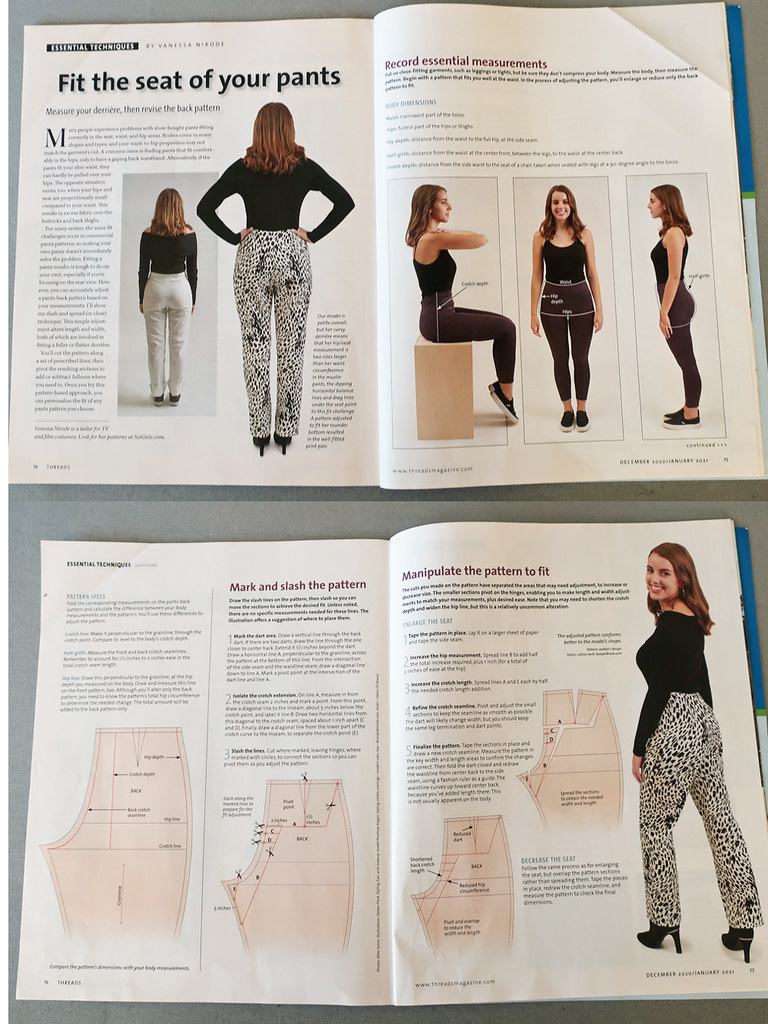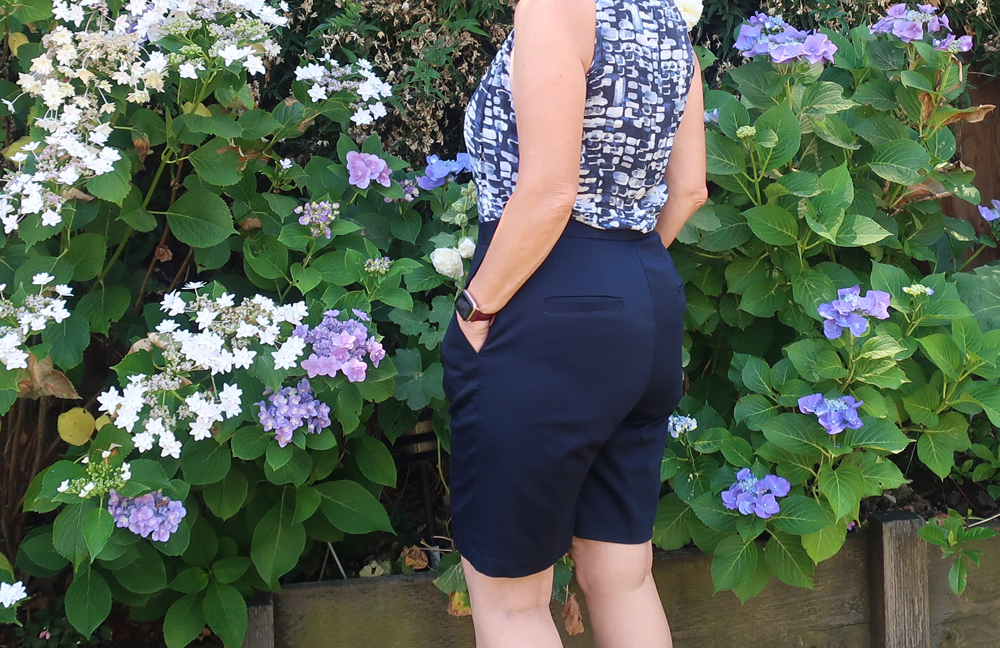After the last year when I have sewn several dresses (like this and this) that have not really been worn during this weird year, I figured it was time to start off my summer sewing with some more practical separates. (And I will wear those dresses soon:). Once I made the first version of the Tatjana Trousers from Just Patterns I was really impressed with them and resolved to try them as shorts. You can see my second version here paired with my vintage Vogue tweed blazer.
When I sewed that black pair, I had just read an article in Threads magazine showing how to make fit adjustments to the back of pants which I tried. Fitting magic! or at least a fitting adjustment that was ideal for my needs.
Here are my finished shorts. Which have no pleats. More on that pattern modification below.

Here's the front of the shorts, with the photo lightened a bit so you can hopefully see details. Actually the absence of details, as I removed the the front pleats. This pants pattern has what I consider a high waist, or at least hits at the natural waist which is above where most pants patterns are designed. This is ideal for me as I have a very long rise for a short person. For comparison the finished zipper length here is 7" whereas on my Ash jeans the zipper is 5.25" long.

I had been thinking about how to remove the pleats for a while and then I saw an Instagram post from @
elmeretakespictures who showed how she was removing the pleats of the Flint trousers using a
tutorial from the Megan Nielsen blog. Exactly what I was looking for! What do we call that when someone posts on the sewing intterwebs the exact thing you are thinking about? Sewindipity? I'm going to start using that.
So here is my explainer of how I did it. Not exactly a tutorial but hopefully you get the idea. Here's the front pattern piece of the Tatjana trousers with the existing pleat fold lines shown. One small pleat next to the pocket edge and then a larger pleat in the middle.

To remove the pleats, I followed the method from the Megan Nielsen blog and overlapped the larger pleat, taking up the excess length horizontally by also slashing the pattern there and overlapping. For the smaller pleat I just used my standard method of folding it out in the pattern paper and smooshing it where it got to the end. Then I needed to fill it the top edge to make it smooth for attaching the waistband. I did forget to check the pocket pieces so they didn't catch complete in the waistband seam bt I will go back and add a bit of height to that piece to match the pants front piece.

So that's the front, it doesn't change the waist circumference of the pants nor the rise. The back I had already adjusted based on an article in a recent Threads magazine. I continue to subscribe to Threads although now they are reducing it to 4 issues per year, they say more content per issue. But I can say that in each issue I learn something, be it a great big fitting revelation or a small tip that makes sewing easier. Plus their website has a wealth of information - I always suggest to people in my classes to check there first if they are looking for how to do something, very reliable information presented well. I took a picture of the cover of the issue I am referring to for the pants adjustment so you can see which one, Jan 2021 and get an idea of the articles. Better Fitting Pants and Muslin to Pattern How-to, both useful. Although some of their features have the same flaw as the pattern companies - fabric choice! see below.

Here's a look at the article, I was very peeved that they decided to photograph this using that print fabric on the pants. Way to obscure the details! But I wanted to show you how they do the diagrams, they are

Here is my adjusted pattern piece. I added 1/2" in width at the hip, and about 1/2" in length. This adjustment also makes the dart larger. This pattern has 2 back darts and I could have shifted some of the increase to the other dart but for now I left it as is. I have highlighted in pin the addition. I then needed to redraw the pocket to make it straight but otherwise this is a great way of adjusting just the pants back, adding space where needed and keeping the side seams unchanged.

OK I guess you want to see the pants back on me, so here is one picture. It's not likely I will wear tops tucked in with shorts but I think with wool trousers I would. Perhaps if I make this winter I might put pocket flaps just to break up that expanse on the backside and add some interest there. In any case I'm pretty satisfied with these adjustments and now I plan to use this same pattern to make a more narrow leg pant (
using this article that I also came across on the Threads website)


I meant to topstitch around the entire welt pocket which is a detail you see on khaki pants or shorts. Next time.
One other change I made was to narrow the width of the waistband. As designed it's a bit too wide for me and so I just added interfacing then trimmed away the extra. These shorts gave me an opportunity to use some of the many packages of waistband interfacing I have accumulated after going to many many rummage sales. The type of waistband interfacing only works well on straight waistbands but if your pattern does have one then it is really quick and easy to use and makes a stiff waistband that doesn't crumple.

Another look at my shorts, plus a top I started a while ago and recently finished. I'm not crazy about it but it's nice to wear on a warm day since it is the most floaty rayon lawn.



I quite like the neckline and the upper part but the body had too much fabric so I took out some of the pleats and also some width at the side seam. Perhaps it needs that tie as shown in the pattern. I think it just has too much fabric in the front, not my style.
So that's the latest on my new shorts. If you make this pattern I defy you to refrain from putting your hands in the pockets at all times. Irresistible! Worn here with one of my favorite t-shirts, I think it's a McCalls pattern mash-up. Made with this Art Gallery knit from a few years back. Such good quality and I love the fabric. I keep looking at their fabrics but nothing has grabbed me again. Kind of pricey but I only need 1 yard to make a top and considering how often I wear this it's a very good value.

I just started a chambray shift dress with a pattern I found in a 1998 Burda magazine. (Is 1998 vintage? or just old?) I have one online class for July which is Sew Lab. Just a 3 session class where you can ask any questions and get help with unfinished projects, advice on new ones and just sew together a bit. Then in August I'm taking a break and then we start some in-person classes in September, Yay!!
I will have details soon.
Happy Summer Sewing,
Beth
Today's garden photo, a look at my hollyhocks next to the hydrangeas, which you saw in the photo above. This is the 3rd year for the hollyhocks and they are bursting with blooms. Despite living in dry N. California I do like the cottage garden look, so I'm really pleased with these and will get some other colors next year.





















0 Yorumlar